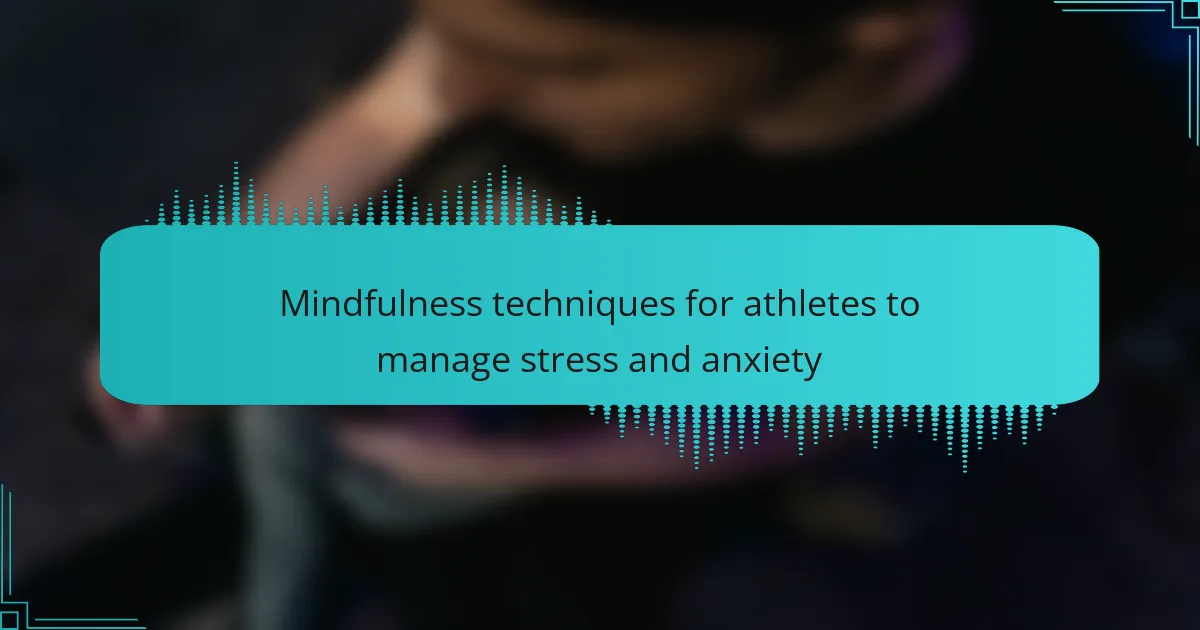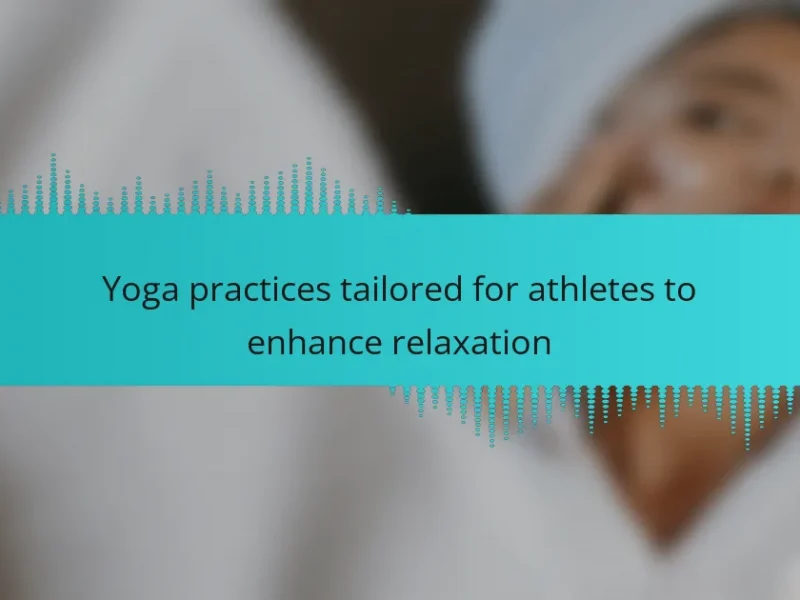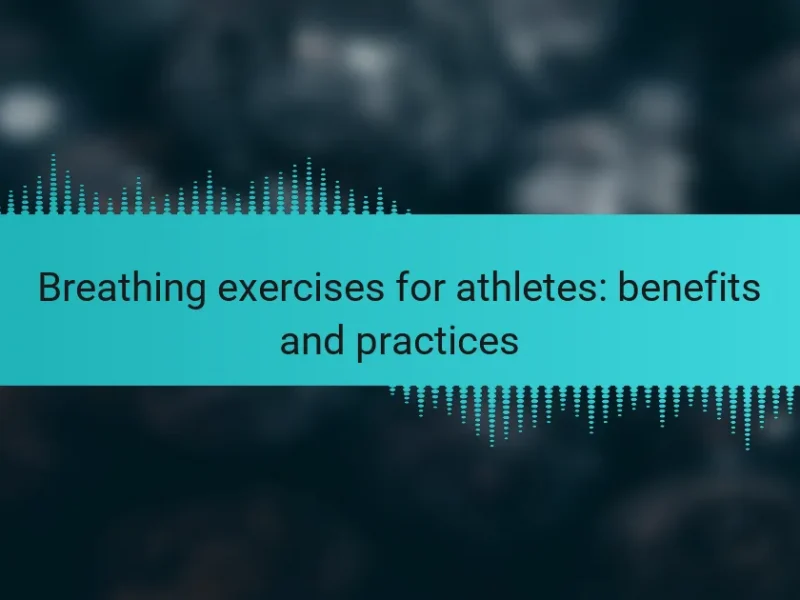Athletes often face significant stress and anxiety that can hinder their performance. Mindfulness techniques such as focused breathing, visualization, and body scanning can enhance mental clarity and emotional regulation. These practices help athletes manage pressure, reduce tension, and improve overall performance. Regular implementation of these techniques fosters resilience and composure during competitions.

What are mindfulness techniques for athletes to manage stress and anxiety?
Mindfulness techniques for athletes to manage stress and anxiety include focused breathing, visualization, and body scanning. These practices enhance mental clarity and emotional regulation, allowing athletes to perform under pressure.
Focused breathing involves deep, rhythmic inhalations and exhalations to centre thoughts and reduce tension. Visualization entails imagining successful performances to boost confidence and alleviate anxiety. Body scanning encourages awareness of physical sensations, helping athletes release stress and tension.
Research shows that consistent practice of these techniques can significantly lower stress levels and improve overall performance. For instance, athletes who engage in mindfulness report 30% less anxiety during competitions.
How does mindfulness impact athletic performance?
Mindfulness significantly enhances athletic performance by reducing stress and anxiety. Techniques such as focused breathing and visualization help athletes maintain composure under pressure. Research indicates that mindfulness practices can improve concentration, leading to better decision-making during competitions. Additionally, regular mindfulness training fosters resilience, enabling athletes to recover more effectively from setbacks. Athletes who incorporate mindfulness experience increased mental clarity and heightened awareness of their physical state, which can improve overall performance metrics.
What are the psychological benefits of mindfulness for athletes?
Mindfulness techniques significantly enhance athletes’ psychological well-being by reducing stress and anxiety. These practices foster improved focus, emotional regulation, and resilience, leading to better performance outcomes. Mindfulness cultivates self-awareness, allowing athletes to recognise and manage their thoughts and feelings effectively. Research indicates that regular mindfulness practice can lower cortisol levels, contributing to reduced stress. Additionally, athletes report increased confidence and a greater sense of control over their performance, which can lead to improved competitive results.

What are the universal mindfulness techniques used by athletes?
Athletes commonly use mindfulness techniques to effectively manage stress and anxiety. Techniques include focused breathing, visualization, body scanning, and mindful movement.
Focused breathing helps athletes centre their thoughts and reduce anxiety by regulating their breath. Visualization allows them to mentally rehearse performances, enhancing confidence and focus. Body scanning promotes awareness of physical sensations, helping athletes recognise tension and release it. Mindful movement integrates mindfulness into physical activity, improving concentration and performance.
These techniques not only improve mental resilience but also enhance overall athletic performance.
How can breathing exercises reduce anxiety in sports?
Breathing exercises can significantly reduce anxiety in sports by promoting relaxation and focus. These techniques help athletes manage stress responses, leading to improved performance. Controlled breathing lowers heart rate and decreases cortisol levels, which are linked to anxiety. Research indicates that athletes using breathing exercises report lower anxiety levels and enhanced concentration during competition. Engaging in these practices regularly can create a unique mental resilience, allowing athletes to perform under pressure effectively.
What are the steps for effective diaphragmatic breathing?
Diaphragmatic breathing involves a series of steps to enhance mindfulness and reduce stress. First, find a comfortable position, either sitting or lying down. Second, place one hand on your chest and the other on your abdomen. Inhale deeply through your nose, allowing your abdomen to rise while keeping your chest still. Then, exhale slowly through your mouth, feeling your abdomen fall. Repeat this process for several minutes, focusing on your breath. This technique helps athletes manage anxiety and improve performance by promoting relaxation and enhancing oxygen flow.
What role does visualization play in managing stress?
Visualization plays a crucial role in managing stress by enhancing focus and promoting relaxation. It allows athletes to mentally rehearse performances, reducing anxiety and improving confidence. Techniques such as guided imagery can create a calming mental space, which helps in lowering cortisol levels. Research indicates that visualization can lead to significant improvements in performance and stress reduction, making it a vital tool in mindfulness practices for athletes.
How to create a mental imagery routine?
To create a mental imagery routine, athletes should visualize their performance in detail. Start by finding a quiet space and closing your eyes. Picture specific scenarios, focusing on sensory details and emotions. Incorporate positive affirmations to enhance confidence. Practice regularly for optimal results.
How can body scans enhance awareness and relaxation?
Body scans significantly enhance awareness and relaxation for athletes by promoting mindfulness. This technique allows individuals to focus on their physical sensations, reducing stress and anxiety. By systematically observing body parts, athletes develop a deeper connection to their bodies, which aids in stress management. Research indicates that regular practice can lower cortisol levels and improve overall mental clarity. This unique attribute of body scans fosters a heightened state of awareness, enabling athletes to perform better under pressure.

What unique mindfulness practices can athletes adopt?
Athletes can adopt unique mindfulness practices such as visualization, body scanning, and mindful breathing. Visualization enhances focus by mentally rehearsing performance scenarios, while body scanning promotes awareness of physical sensations, reducing tension. Mindful breathing helps regulate emotions and maintain composure during competition. Integrating these techniques cultivates resilience and mental clarity.
How does mindful movement contribute to stress relief?
Mindful movement significantly reduces stress by enhancing awareness and promoting relaxation. Techniques like yoga and tai chi encourage athletes to focus on their breath and body, fostering a calm state. Research shows that these practices lower cortisol levels, improving emotional regulation. Mindful movement also cultivates resilience, helping athletes manage anxiety effectively during competitions.
What are examples of mindful movement exercises?
Mindful movement exercises include yoga, tai chi, qigong, walking meditation, and body scan techniques. These practices enhance body awareness and promote relaxation, helping athletes manage stress and anxiety effectively. Each exercise encourages focus on breath and movement, fostering a deeper connection to the present moment.
What is the significance of mindful eating for athletes?
Mindful eating significantly benefits athletes by enhancing focus and reducing stress. This practice encourages athletes to pay attention to their food choices and eating habits, promoting better nutrition and performance. Mindful eating fosters a deeper connection to food, which can lead to improved mental clarity and emotional regulation. As a result, athletes experience reduced anxiety levels, enabling them to perform under pressure more effectively. Engaging in this technique can also support recovery, as athletes become more aware of their body’s needs and signals during training and competition.

What rare mindfulness techniques are emerging in sports?
Emerging mindfulness techniques in sports include breathwork, visualization, and nature immersion. These methods help athletes manage stress and anxiety, enhancing performance. Breathwork focuses on controlled breathing patterns to promote calmness. Visualization involves mental imagery to prepare for competition and reduce anxiety. Nature immersion encourages athletes to connect with the outdoors, fostering relaxation and mental clarity. These rare techniques are gaining traction as athletes seek innovative ways to improve their mental resilience.
How can nature immersion benefit athletic mindfulness?
Nature immersion enhances athletic mindfulness by reducing stress and anxiety. Engaging with natural environments fosters mental clarity and emotional resilience. Studies show that spending time in nature can lower cortisol levels, improving focus and performance. Athletes often report increased motivation and a greater sense of connection to their surroundings, which can enhance their mental game.
What is the impact of sound meditation on performance?
Sound meditation positively impacts athletic performance by reducing stress and anxiety. It enhances focus, promotes relaxation, and improves recovery time. Athletes who practice sound meditation report increased mental clarity and emotional stability, leading to better performance under pressure. This technique helps in managing pre-competition nerves, allowing athletes to maintain peak performance levels.

How can athletes implement mindfulness techniques in training?
Athletes can implement mindfulness techniques in training by incorporating focused breathing, visualization, and body scans. These practices enhance concentration and reduce stress.
Focused breathing involves taking deep, slow breaths to calm the mind and body, helping athletes maintain composure during high-pressure situations. Visualization allows athletes to mentally rehearse their performance, fostering confidence and clarity. Body scans promote awareness of physical sensations, enabling athletes to identify and release tension.
Integrating these techniques into daily routines can lead to improved emotional regulation and enhanced performance. Regular practice cultivates a resilient mindset, essential for overcoming challenges in competitive sports.
What are the best practices for integrating mindfulness into daily routines?
To integrate mindfulness into daily routines, athletes should practice techniques that reduce stress and anxiety. Start with focused breathing exercises to enhance concentration. Incorporate short meditation sessions, ideally before training or competitions, to centre thoughts. Use visualization techniques to mentally rehearse performance, fostering a calm mindset. Finally, establish a gratitude practice, reflecting on positive experiences to cultivate resilience. These practices enhance mental clarity and emotional balance, crucial for athletic success.
What common mistakes should athletes avoid when practicing mindfulness?
Athletes should avoid common mistakes like multitasking during mindfulness, setting unrealistic expectations, and neglecting consistency in practice. These pitfalls can hinder stress and anxiety management. Instead, focus on being present, establishing a routine, and understanding that mindfulness is a skill developed over time.
How can coaches support athletes in mindfulness practices?
Coaches can support athletes in mindfulness practices by integrating techniques into training routines. They can guide breathing exercises, promote visualization strategies, and encourage regular meditation sessions. These practices help athletes manage stress and anxiety effectively. Research shows that mindfulness can enhance performance by improving focus and emotional regulation. Coaches can also create a supportive environment, fostering open discussions about mental health and mindfulness.
What expert insights can enhance mindfulness application in sports?
Mindfulness techniques enhance athletes’ performance by reducing stress and anxiety. Techniques such as focused breathing, visualization, and body awareness can significantly improve mental resilience. Research indicates that consistent mindfulness practice can lower cortisol levels, leading to better emotional regulation. Athletes who incorporate these techniques report increased focus and improved overall well-being.


